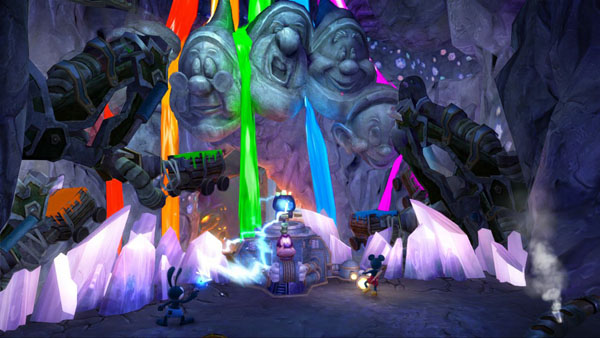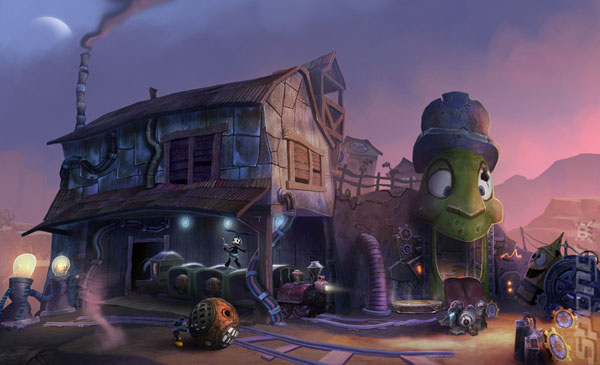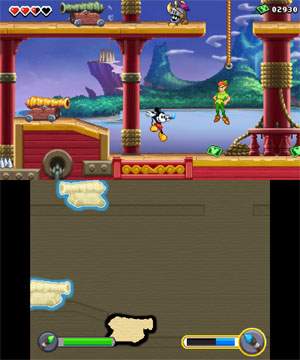Epic Mickey 2: The Power of Two Review by Ian Abbott
Epic Mickey 2: The Power of Two is the sequel to Epic Mickey – a meta-fictional plot that mirrored Oswald the Lucky Rabbit’s history of how he dealt with his feelings of abandonment at the hands of Walt Disney. In 2006 Disney President Bob Iger made good on a promise to bring Oswald back into the family and the intellectual property plus back catalogue of original Disney/Oswald films was exchanged with NBC for Al Michaels (an American Football commentator) who was under contract with Disney at the time. Contractual issues sorted, in between games they’ve buried the hatchet, teamed up and decided to rebuild Wasteland together after a series of earthquakes.

The landscape and premise of Epic Mickey 2 is a continuation from the original and sees the game mining retired characters and attractions from the House of Disney. The art designers have had an absolute field day from rich concept art all the way through to the final luxurious execution, art is the lifeblood of the game. There are dozens of knowing references to a nostalgic past; from an effervescent rainbow waterfall featuring the dwarfs from Snow White to a crumbling oversized Jiminy Cricket train station entrance where his jaw opens after revealing the source of electrical power. It is joy enough to just exist in these new Disney landscapes, drinking in the visual nods and exploring themed lands that time forgot.
Painting is central to the character mechanics as Mickey wields a magical brush that squirts paint (fills in part of the environment) or thinner (deletes scenery and objects) and is a delightful way of engaging with the world; early on I consistently tested the structural possibilities of rock, cacti, soldiers and all sorts of other environmental furniture. However, as the game progressed, I felt there was little variation in how this ability could be applied over the 14 hours it takes to complete the game and the constant draining of my limited paint supplies to try and see if the scenery could be made (in)visibled was a direct contradiction to my earlier unremitting attempts at becoming a Disney Jackson Pollock.
Billed as a “video game musical” (I’d love to see a genuine combination of my two favourite cultural entertainments), the reality is somewhat disappointing. A few characters break into short songs - my favourite being I’m Falling Apart by the Mad Doctor with his mournful Tom Waits tones - during animated cut scenes but unfortunately the music design is not woven into the game fabric and leaves me questioning its purpose and relevance to the integrity of the game.

With part of the games title indicating a reliance upon a significant other to aid me through toon town, it is with a sadness that when playing with AI Oswald, I found myself on a vocal scale of somewhere between low grumbly mutterings to all out beetroot rage at the sheer unreliability and inconsistency of his actions. Sometimes he’d flail around, sometimes self plummet into goo of destruction and sometimes he’d do what was required. To help soothe my frustrations, I asked Tracey to jump in as a two player local co-op and happy stability ensued for the couple of hours we played together.
With a PEGI rating of 7+, I think the game has been pitched off. The persistence and level of exploration needed to get through both the 2D platform and 3D landscapes is more akin to gamers aged 12+ who would expect deeper moral complexities or a higher joy payoff in return for the time invested; an 8 year old is simply going to give up. There are dozens of neat touches like using cinema projectors to travel between worlds, local co-op with a trusting comrade and the consistent incredible visual finesse but as a game it is confused and a mechanical mess. If you’re looking for a developer who can take on a strong global brand and consistently create memorable and funny games which appeal to both adults and children you’re going to have to go a long way to beat what the good folks at Tt Games have done with Lego.
Epic Mickey: Power of Illusion Review by Tracey McGarrigan
Epic Mickey: Power of Illusion is the first Nintendo 3DS™ title in the modern “Epic Mickey” series but has its roots way back in 1990 as it heavily borrows from the SEGA Genesis/Mega Drive classic Castle of Illusion Starring Mickey Mouse.

Though the game manual would suggest that Power of Illusion takes place directly after the events of Epic Mickey 2: The Power of Two (see above for Ian’s review), the Wasteland takes a back seat as all the action takes place in the castle where Mickey travels to the sandy streets of Agrabah (Aladdin), the whirlpool conveyor belt currents and coral reefs under the sea (The Little Mermaid) and my personal favourite the starry skied rooftops of London and Captain Hook’s ship (Peter Pan). The inventive and surprising locations found in the original Castle of Illusion (like a whole world made of chocolate and cake) or in The Power of Two (Rainbow Cavern or the Gulch Mines) are replaced with more familiar locations from the Disney back-catalogue yet fans should be delighted at the range of characters and locations they will encounter along the way.

Finding trapped toons freed them up to create special themed chambers in the castle where they made themselves at home. Despite Mickey saving their cartoon souls, they were still pretty demanding, often asking for assistance with extra chores which usually involved tracking down items or friends lost and scattered throughout the Castle. Though the rewards meant Mickey could upgrade or unlock new techniques to improve his chances, sadly, the copious amounts of backtracking and replaying through old levels in order to find the items quickly lost its charm and appeal. There were some requests in the end I totally ignored which probably made the final level (where in classic style Mickey had to fight every type of enemy he had encountered on the way before his tricky final showdown with Mizrabel) harder than it should have been.
Despite the pace and backtracking, Epic Mickey: Power of Illusion is the most fun I’ve had on the 3DS in some time. As a modern translation of a classic Disney platformer, Power of Illusion is a fabulous addition to the series. The paintbrush options offered me more to do yet didn’t move away the core charm, theme or gameplay found in the original Castle of Illusion. The genuine skill needed to perfectly time Mickey’s jump and swings remains and isn’t as easy as it’s cartoon façade would suggest meaning the side-scrolling platforming feels good plus it looks great in 3D. There were even the same overtones in the soundtrack which means retro gamers and Disney fans too young to remember Mickey’s first adventure in the castle should all enjoy this title.